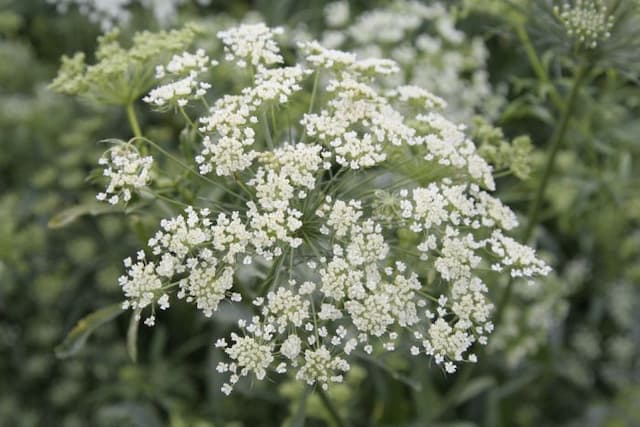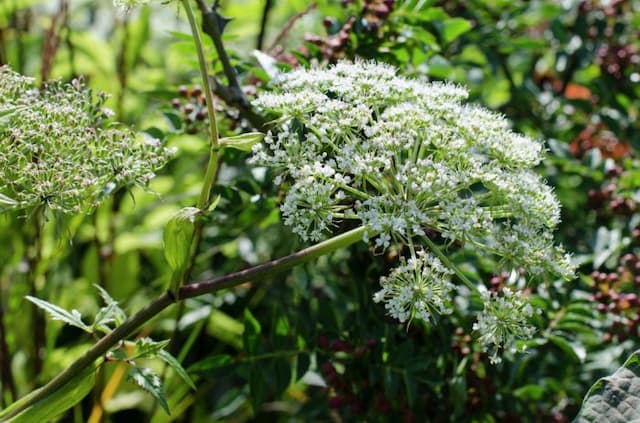Wild Angelica Angelica sylvestris

ABOUT
Angelica sylvestris, commonly known as wild angelica, is a visually striking plant. Its appearance is characterized by large, deeply cut green leaves that give off a slightly pungent scent when crushed. These are divided into numerous small leaflets which are arranged in pairs, with a single leaflet at the tip. The foliage forms a lush, dense, and shrub-like presence. The plant is crowned during late summer with large, rounded clusters of tiny flowers that could be described as a sophisticated shade of pinkish, cream-like color. These small flowers are grouped together in umbrella-like heads, called umbels, which spread out in a striking display, attracting a host of pollinators such as bees and butterflies. The stems of wild angelica are thick, rounded, and hollow, with a grooved surface, and have a tendency to become reddish-purple near the base. They are smooth and hold the leaves and flower clusters upright, creating a canopy of sorts over the leafy part of the plant. Overall, wild angelica has a robust and lush appearance, with the leaves and flower clusters contributing to its bushy and wild character, which is often seen in meadows, damp grasslands, and alongside rivers where it prefers to grow.
About this plant
 Names
NamesFamily
Apiaceae
Synonyms
Wild Angelica, Wild Parsnip, Holy Ghost, Norwegian Angelica
Common names
Angelica montana Brot., Angelica nemorosa Schrank, Angelica pratensis Mill., Archangelica officinalis Hoffm., Archangelica sylvestris Hoffm., Selinum sylvestre Krause.
 Characteristics
CharacteristicsLife cycle
Biennials
Foliage type
Deciduous
Color of leaves
Green
Flower color
White
Height
3-8 feet (0.9-2.4 meters)
Spread
1-3 feet (0.3-0.9 meters)
Plant type
Herb
Hardiness zones
4
Native area
Europe
Benefits
 General Benefits
General Benefits- Culinary Use: Angelica sylvestris, commonly known as wild angelica, can be used in cooking, particularly the stems and seeds, which add flavor to various dishes.
- Ornamental Value: With its tall structure and umbels of cream-colored flowers, wild angelica can be an attractive addition to gardens and landscapes.
- Pollinator Attraction: Wild angelica flowers are known to attract beneficial insects such as bees and butterflies, which aid in pollination.
- Biodiversity Support: By providing habitat and food for various species, wild angelica plays a role in maintaining local biodiversity.
- Soil Improvement: As a deep-rooted plant, wild angelica can help improve soil structure and nutrient availability.
- Erosion Control: The robust root system of wild angelica can help stabilize soil and reduce erosion, especially on slopes and riverbanks.
- Traditional Uses: While excluding medical properties, it is recognized that wild angelica has been used in traditional practices for various non-medicinal applications, such as in rituals or as a flavoring agent.
- Education and Research: Angelica sylvestris can be used as a subject for botanical education and research, contributing to our understanding of plant biology and ecology.
 Medical Properties
Medical Properties- Diuretic: Angelica sylvestris has been traditionally used to promote urine production and relieve fluid retention.
- Carminative: It may help in reducing gastric discomfort by facilitating the expulsion of gas from the intestines.
- Expectorant: The plant is used traditionally to help in the removal of mucus from the respiratory tract.
- Antipyretic: Angelica sylvestris has been employed to help reduce fever.
- Stimulant: It is sometimes used as a stimulating tonic for various bodily functions.
 Air-purifying Qualities
Air-purifying QualitiesThis plant is not specifically known for air purifying qualities.
 Other Uses
Other Uses- Angelica sylvestris, commonly known as wild angelica, can be used as a natural insect repellent, as the strong aroma may help deter certain insects and bugs.
- The seeds of wild angelica have been utilized in perfumery due to their musky, earthy fragrance that adds complexity to aromatic compositions.
- Wild angelica stalks can be candied and used as a unique decoration for desserts, providing a subtle, sweet flavor and an interesting visual presentation.
- The plant's fibrous stems have been historically used in the production of small handicrafts like woven baskets or simple rustic tools.
- Wild angelica foliage can serve as a natural dye, coloring fabrics a light green to yellow hue, depending on the mordant used.
- The dried leaves of wild angelica are sometimes incorporated into potpourris for their visual appeal and pleasant scent.
- In some regions, the plant has been used as a fodder crop for livestock, especially sheep, which find the foliage palatable.
- Culinary enthusiasts use the young shoots of wild angelica similar to how one might use celery in salads or as a flavoring in soups and stews.
- Wild angelica's large, hollow stems can be repurposed creatively as natural straws for sipping on cold beverages.
- During traditional country fairs, the plant's flowering umbels have been used as a makeshift paintbrush for folk art or as part of children's nature crafts.
Interesting Facts
 Feng Shui
Feng ShuiThe Wild Angelica is not used in Feng Shui practice.
 Zodiac Sign Compitability
Zodiac Sign CompitabilityThe Wild Angelica is not used in astrology practice.
 Plant Symbolism
Plant Symbolism- Protection - Angelica sylvestris, commonly known as Wild Angelica, is traditionally believed to ward off negative energies and protect against evil spirits.
- Healing - Due to its medicinal properties, Wild Angelica symbolizes healing and is thought to be beneficial for various health issues.
- Inspiration - As the name suggests, Wild Angelica is often associated with angelic realms and can represent divine inspiration and enlightenment.
- Purification - The plant is sometimes used in purification rituals, symbolizing the cleansing of the mind, body, and spirit.
 Water
WaterWild Angelica prefers moist soil, so it's important to water regularly. Depending on weather conditions, water the plant with about 1 gallon per week, ensuring the soil is consistently damp but not waterlogged. During hot, dry periods, the frequency may need to increase to twice a week. However, during the winter or in cooler climates, you can reduce watering as the plant requires less moisture. Always check the top inch of soil for dryness before watering to avoid over-watering.
 Light
LightWild Angelica thrives in full sun to partial shade. It's best positioned in a spot where it will receive at least 4 hours of direct sunlight each day, with dappled light or light shade during the hottest part of the afternoon. This will ensure the plant receives enough light to grow but is protected from the potentially harmful effects of too much intense sunlight.
 Temperature
TemperatureWild Angelica grows best in temperatures between 60°F and 75°F and can tolerate temperatures down to 40°F. It's hardy and can withstand colder conditions, but to maintain healthy growth, it should not be exposed to temperatures below 40°F for prolonged periods.
 Pruning
PruningPruning Wild Angelica is mainly done to remove spent flowers and encourage new growth. Prune the plant back after flowering, usually in early spring. This will prevent the plant from self-seeding excessively and promote a bushier growth. It's best to prune before new growth begins, but take care not to prune too late in the season, as the new shoots may be damaged by frost.
 Cleaning
CleaningAs needed
 Soil
SoilWild Angelica thrives in moist, fertile soil with good drainage. The best soil mix should contain equal parts loam, peat, and organic compost with a pH of 6.0-7.0 to mimic its natural habitat.
 Repotting
RepottingWild Angelica is a biennial plant and does not typically require repotting. Instead, sow fresh seed every year in situ as the plant will self-seed once established.
 Humidity & Misting
Humidity & MistingWild Angelica prefers a natural, outdoor environment and tolerates average outdoor humidity levels well. It does not require specific humidity adjustments.
 Suitable locations
Suitable locationsIndoor
Grow Wild Angelica in bright, indirect light with regular water.
Outdoor
Plant Wild Angelica in partial shade, in moist soil.
Hardiness zone
4-9 USDA
 Life cycle
Life cycleAngelica sylvestris, commonly known as wild angelica, begins its life as a seed that germinates in the spring, typically in moist, fertile soil. The seedling grows into a rosette of leaves during the first year, establishing a robust root system. In the second year, the plant bolts by sending up a tall flower stalk, which then blooms in the summer, bearing umbels of small white or pale pink flowers that attract a variety of pollinators. After pollination, these flowers develop into dry, winged fruits known as schizocarps, which disperse to new locations. The plant completes its lifecycle by dying after seed production, being a biennial species. Throughout its life, wild angelica provides habitat and food for insects and serves as a host for various species of butterflies and other pollinators.
 Propogation
PropogationPropogation time
Spring to early summer
Wild angelica, or Angelica sylvestris, is commonly propagated by seed. The best time to sow seeds is either in autumn soon after they mature or in early spring. To propagate by seed, prepare a well-draining soil bed in a sheltered spot with partial shade. Sow the seeds thinly on the soil surface and cover them lightly with a thin layer of soil, about 1/8 inch (approximately 3 mm) deep. Keep the soil moist until the seeds germinate. Seedlings can later be transplanted to their final growing positions when they are large enough to handle, typically when they've developed a couple of true leaves. This method is favored due to its simplicity and effectiveness in producing new plants that are true to the parent.








